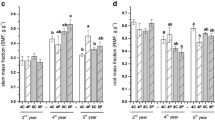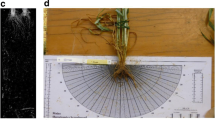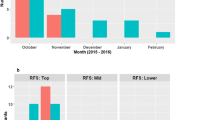Abstract
Nursery grown 1–0 bareroot sweetgum seedlings were lifted and graded into two diameter classes (12–16 and 4–8 mm) during the dormant season. Large and small grades were top and/or root pruned and then outplanted on two sites in the lower Coastal Plain of the southeastern United States. Seedling shoots were pruned to 50% of tree height, a 5 cm stump, or no pruning. Seedling roots were pruned to a 15 cm length or left unpruned. Site affected survival but not growth. Smaller, top pruned seedlings performed worse on one site, probably due to greater weed competition. Large seedlings increased survival and growth which increased 3 year average plot volumes by 89%. Top pruning stimulated height growth, but reduced diameter growth and decreased third year seedling volumes. Root pruning did not affect seedling growth. Diameter growth may better indicate treatment impact that height, which has been most commonly used in previous studies.
Similar content being viewed by others
References
J.C. Adams (1985) Severe top pruning improves water oak seedling growth E. Shoulders (Eds) Proceedings of the Third Biennial Southern Silvicultural Research Conference Gen. Tech. Rep. SO-54. US Department of AgricultureForest ServiceSouthern Forest Experiment Station New Orleans, LA 1–3
R.P. Belanger R.G. McAlpine (1975) ArticleTitleSurvival and early growth of planted sweetgum related to root-collar diameter Tree Planters’ Notes 26 IssueID4 1–21
E.F. Brantley W.H. Conner (1997) ArticleTitleGrowth of root-pruned seedlings in a thermally impacted area of South Carolina Tree Planters’ Notes 48 IssueID3 76–80
T.A. Dierauf J.W. Garner (1996) ArticleTitleEffect of initial root collar diameter on survival and growth of yellow-poplar seedlings over 17 years Tree Planters’ Notes 47 30–33
A. Kaszkurewicz T. Keister (1975) ArticleTitleEffects of intensive cultural treatments and seedling size on juvenile growth of sweetgum Tree Planters’ Notes 26 5–8
P.P. Kormanik (1986) ArticleTitleLateral root morphology as an expression of sweetgum seedling quality For. Sci. V 32 IssueID3 595–604
D. McCreary J. Tecklin (1994) ArticleTitleTop pruning improves field performance of blue oak seedlings Tree Planters’ Notes 44 73–77
McNabb K. 2001. Growth of sweetgum two years after planting three seedling sizes across three herbaceous weed control treatments. Auburn University Southern Forest Nursery Management Cooperative. Research Report 01-11. 3 pp.
Mc Nabb K. and VanderSchaaf C. 2003. A survey of forest tree seedling production in the South for the 2002–2003 planting season. Auburn University Southern Forest Nursery Management Cooperative. Technical Note 03-02. 10 pp.
J.S. Meadows J.R. Toliver (1987) ArticleTitleThree-year response of pecan to six methods of seedling establishment South. J. Appl. For. 11 56–59
T.E. Russell (1973) ArticleTitleSurvival and growth of bar-slit planted northern red oak studied in Tennessee Tree Planters’ Notes 24 IssueID3 6–9
InstitutionalAuthorNameSAS Institute Inc. (1985) Statistical Analysis System’s User’s Guide Basics, Version, 5 ed SAS Institute Inc. Cary, NC
D.B. South (1996) ArticleTitleTop-pruning bareroot hardwoods: a review of the literature Tree Planters’ Notes 47 34–40
South D.B. 1997. Top pruning sweetgum after planting. Auburn University Southern Forest Nursery Management Cooperative Research Report 97-5. School of Forestry and Wildlife Sciences, Auburn University. Auburn, AL.
D.B. South (1999) Top pruning sweetgum – An update Auburn University Southern Forest Nursery Management Cooperative Research Report 99-3. School of Forestry and Wildlife Sciences, Auburn University Auburn, AL
K.A. Sterling C.L. Lane (1975) ArticleTitleGrowth and development of shoot and root pruned yellow-poplar seedlings at two sites Tree Planters’ Notes 26 IssueID3 1–2
J.R. Toliver R.C. Sparks T. Hansbrough (1980) ArticleTitleEffects of top and lateral root pruning on survival and early growth on three bottomland hardwood species Tree Planters’ Notes 31 13–15
J.J. Zaczek K.C. Steiner T.W. Bowersox (1997) ArticleTitleNorthern red oak planting stock: 6-year results New Forests 13 177–191 Occurrence Handle10.1023/A:1006578007777
Author information
Authors and Affiliations
Corresponding author
Rights and permissions
About this article
Cite this article
Mc Nabb, K., VanderSchaaf, C. Growth of graded sweetgum 3 years after root and shoot pruning. New Forest 29, 313–320 (2005). https://doi.org/10.1007/s11056-004-5654-7
Received:
Accepted:
Issue Date:
DOI: https://doi.org/10.1007/s11056-004-5654-7




